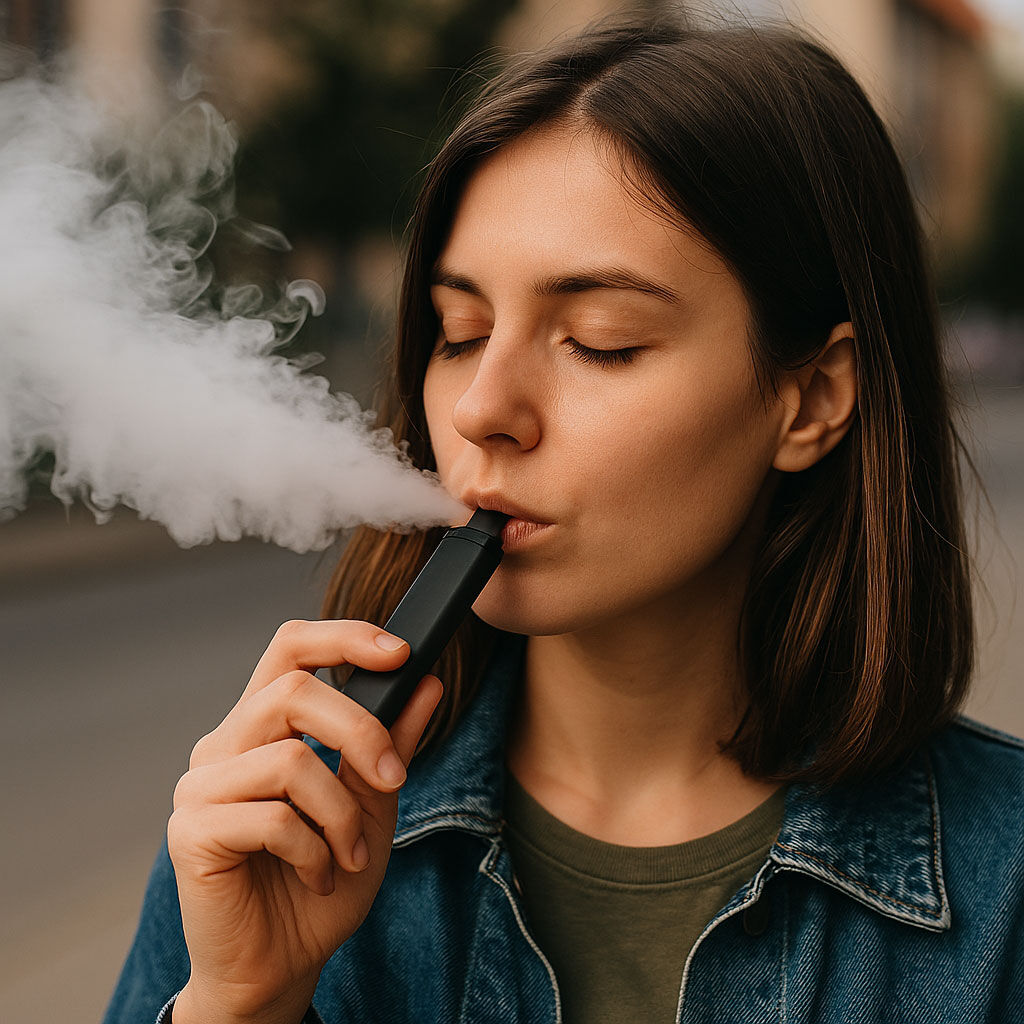If you've ever asked yourself, "How to stop vaping on 5% nicotine", you're not alone. At 5% nicotine or 50mg/ml, satiating your nicotine ingestion can feel constant and overwhelming. Delivering high doses of nicotine in a short time, you may feel the constant urge to vape, which can inadvertently affect your health. Which, now, may be the adverse goal when you first started vaping- to quit smoking. Not only satisfying, but also a reliance - the habit feels chemical, and that's because it is.
Whether you're ready to stop entirely or still figuring out what works, this guide helps you understand the science behind nicotine, avoid common pitfalls, and start your tapering journey with confidence.
What Makes 5% Nicotine So Addictive?
The nicotine in your vape isn't just strong-it's engineered to be hard to quit. Most 5% vape devices use nicotine salts, a modified form of nicotine that absorbs faster into your bloodstream. Unlike traditional freebase nicotine found in older vape juices, nicotine salts are smoother to inhale at higher concentrations, meaning you can take longer, deeper puffs without throat irritation- making it easier to ingest considerable amounts of nicotine.
A typical 5% vape contains around 50mg of nicotine per milliliter, which is roughly the same as or sometimes even more than a whole pack of cigarettes. The difference is in delivery. Cigarettes burn out. But with a 5% vape, you can take hundreds of hits without interruption, and the act of vaping is so discreet that it fits into more moments of the day: waking up, working, driving, scrolling your phone.
That constant access leads to repeated dopamine spikes, which rewire the brain's reward system over time. Every hit reinforces the behavior, training your brain to seek more. Eventually, you're not hitting your vape because you enjoy it-you're doing it to avoid the discomfort of not having it.
Research from the National Institute on Drug Abuse shows that nicotine increases activity in the same areas of the brain that light up from gambling, food, and other addictive behaviors. The more often you stimulate those circuits, the harder they are to turn off. And with 5% nicotine products, stimulation happens fast and frequently.
There's also a behavioral layer. High-strength vapes are easy to conceal and socially accepted in ways that cigarettes aren't. That means no smoke breaks, no shame, no limits-just a product you can reach for any time. This blurs the line between occasional use and compulsive use until you're reaching for the device without thinking.
So when people say quitting 5% nicotine is tough, it's not an exaggeration. You're not just quitting a product. You're breaking a chemical loop, a mental habit, and a lifestyle pattern at the same time.
But the brain can adapt. Once the cycle is interrupted and nicotine is removed, dopamine pathways slowly rebuild. That's when cravings start to lose their grip, and you regain control over the habit.
Want to learn more about how nicotine salts work? We've broken it down on our blog.
Understanding Withdrawal from 5% nicotine
Stopping a 5% nicotine vape leads to pushback from your body and mind. Common withdrawal symptoms include:
-
Intense cravings
-
Headaches
-
Restlessness or irritability
-
Trouble sleeping
-
Mood dips or depression
-
Difficulty concentrating
These symptoms typically peak in the first 3-5 days. While physical symptoms ease, mental cravings may last weeks or months.
Learn more in our guide on our blog on the side effects of vaping.

Tapering: A Strategy That's Gaining Ground
Cold turkey works for some, but many vapers find success in tapering-gradually reducing nicotine before quitting altogether.
A 6-week tapering plan may look like this:
-
Week 1: Track and limit daily puffs.
-
Week 2: Switch to 3% nic juice.
-
Week 3: Mix 3% and 2% options.
-
Week 4: Use only 2% juice.
-
Week 5: Replace with zero-nicotine vape juice.
-
Week 6 (optional): Go device-free with supportive routines.
While variying for all individuals, we have found this roadmap to be realistic for those who are trying to taper their nicotine ingestion.
Tapering vs. Cold Turkey: Which Is Better?
It really depends on the invididual. Tapering from nicotine is a safe option, as being heavily reliant on nicotine can cause irritability in comparison to cold turkey. Where with cold turkey, some individuals have less reliance- or can handle the chemical shifts better.
Tapering can help you reduce your nicotine intake- and soften the landing. Where this method of tapering may be the most ideal for heavy usage. On the other hand, cold turkey- if manageable, can help individuals by immediately starting the healing process of reliance. A rather more abrupt break, it significantly improves the detoxing timeline.
There's no universal "best" way. What matters is choosing a method that aligns with your habits and mindset. Some people even combine the two tapering for a few weeks, then cut it off entirely once they reach a lower level.
Supporting Your Quit with Nutrition, Sleep, and Movement
Your body is doing a lot of work when you quit vaping. It's healing and rebalancing systems that high levels of nicotine have disrupted. Supporting that process with healthy routines can make a noticeable difference.
Start with what you eat. Certain foods, such as bananas, eggs, almonds, and leafy greens, can naturally support dopamine production and help reduce cravings. Drinking plenty of water flushes toxins and eases withdrawal headaches. Moving your body also plays a significant role. Even light exercise boosts mood and cuts anxiety, which is a major trigger in the early stages of quitting.
Among nutrition and rebalancing your system, sleep is also one of the most important steps you can take when detoxing from nicotine. As nicotine disrupts your sleep cycle, getting a quality rest is equally essential to ensuring that your pathways are improving from the detox. Having a set wind-down routine of cutting screen time or going to bed a consistent bed-time can all help your body with realligning your system through nicotine detox.

How Long Does It Take to Detox from 5% nicotine?
Physically, nicotine leaves your system in about 72 hours. Mentally, recovery takes longer:
| Timeline | Side Effects |
| Days 1 - 3 | Physical Withdrawal is strongest |
| Days 4-7 | Cravings shift from physical to psychological |
| Weeks 2-4 | Energy balances, mood steadies |
| By Day 90 | Your brain starts forming new, lasting pathways |
Real change usually takes 12 weeks. It's rough at first, but every milestone is real progress.
What Happens If You Don't Quit?
Staying stuck on 5% nicotine often feels easier in the short term, but it can cost more than you think. As you probably have noticed, your brain builds tolerance to nicotine- which then needs more nicotine to feel similar effects- and heavier usage. Aside from the brain reliance, you may notice increased heart rate, blood pressure, and difficulty breathing. Adding that with the hefty cost of higher usage, you can easily rack up more than a few grand from the disposable products alone.
The longer you wait, the harder it becomes to break the habit. But the moment you decide to change, even if you're exploring the idea, you've already started to take that power back.
Let's Quit Together: Your 30‑Day Quit Timeline.
Here's your 30-day roadmap:
-
Days 1-3: Hydrate, track triggers, use distractions
-
Days 4-7: Focus on sleep, movement, and healthy meals
-
Week 2: Shift routines, find new habits
-
Week 3: Add journaling or a support group
-
Week 4: Celebrate one month vape-free
Share Your Story
While we encourage our community to a smoke-free lifestyle, maintaining healthy habits will always be paramount. Available in nicotine-free options, Ruthless encourages every person to take the necessary steps to ensure the longevity of their life. Whether lowering your nicotine usage, only vaping every few days, or plan on quiting, tell us your story! Leave a comment below.




Leave a comment
All comments are moderated before being published.
This site is protected by hCaptcha and the hCaptcha Privacy Policy and Terms of Service apply.